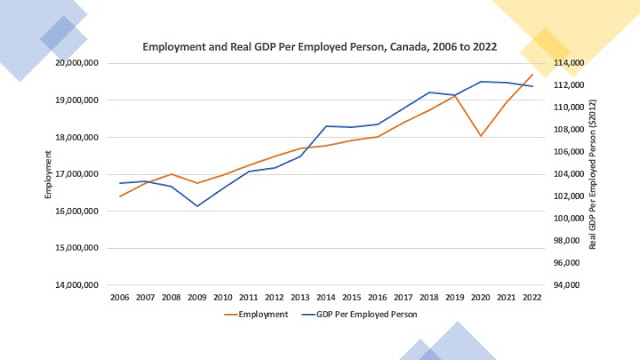Despite what seems to be supply side issues of staff
shortages, rising demand and inflation in the wake of the pandemic, at least
one contrarian view is that Canada’s labour shortage is an illusion. University
of Waterloo economist Mikal Skuterud in a recent Globe
Oped noted that despite perceptions of a labour shortage, Canadian labour
force participation was identical to what it was in October 2018 at 65.7
percent and the absolute size of the labour force at 20.8 million is the
largest it has ever been. The “shortage”
may indeed also be a result of the demand for workers in the post pandemic
surge growing faster than their numbers. Indeed, if one looks at the health sector, the supply of physicians and nurses per capita is the largest it has ever been but the post pandemic surge in dealing with postponed surgeries and procedures has been overwhelming.
However, the problem may be worse than you might think. Not only is the size of the labour force the largest is has ever been but so is total employment. If you look at the number of people employed – producing labour units so to speak - it is three percent higher than it was in 2019. Employment did plunge in 2020 as a result of the pandemic shutdowns but it has since rebounded dramatically – by over 9 percent since 2020. As the accompanying figure illustrates, employment is indeed the highest it has ever been. [Data Sources: Statistics Canada, Table 14100393 Labour force characteristics, annual and
| V62471340 Canada [11124]; Gross domestic product at market prices] |
However, despite more people working than ever before, the output response has been shall we say a bit sluggish? While employment grew by over 9 percent from 2020 to 2022 as pandemic recovery set in, real GDP (in $2012 constant dollars) grew by less than 9 percent. As a result, output per employed person has actually declined since 2020. From 2020 to 2022 real GDP per employed person actually fell by just over one third of one percent.
Something has happened over the course of the pandemic that seems to have affected the productivity of Canadian workers. Perhaps the long shutdown resulted in a deterioration of human capital and skills? Perhaps the retirement of so many experienced workers and their replacement by less experienced entry level workers has led to output disruptions as new workers learn by doing? Or, after the trauma of the pandemic, everyone wants more work life balance and as a result we are simply not working as hard as we used to? Is this simply the aggregate effects of “quiet quitting?”
Such slowdowns in output per employed person are not unique to the pandemic era and based on the chart have occurred before – for example during the Great Recession and also between 2014 and 2016. History suggests that we do recover from these “productivity” slumps and based on past performance one would expect the same over the next couple of years. The disruption of the pandemic will take a number of years to fully work its way through the economy and the social fabric of the country. The bigger problem in terms of productivity is if this time things are going to be different, and the productivity slowdown becomes a permanent feature. Given that Canada has had economic productivity issues for decades, this latest iteration of an old issue is disconcerting to say the least.
